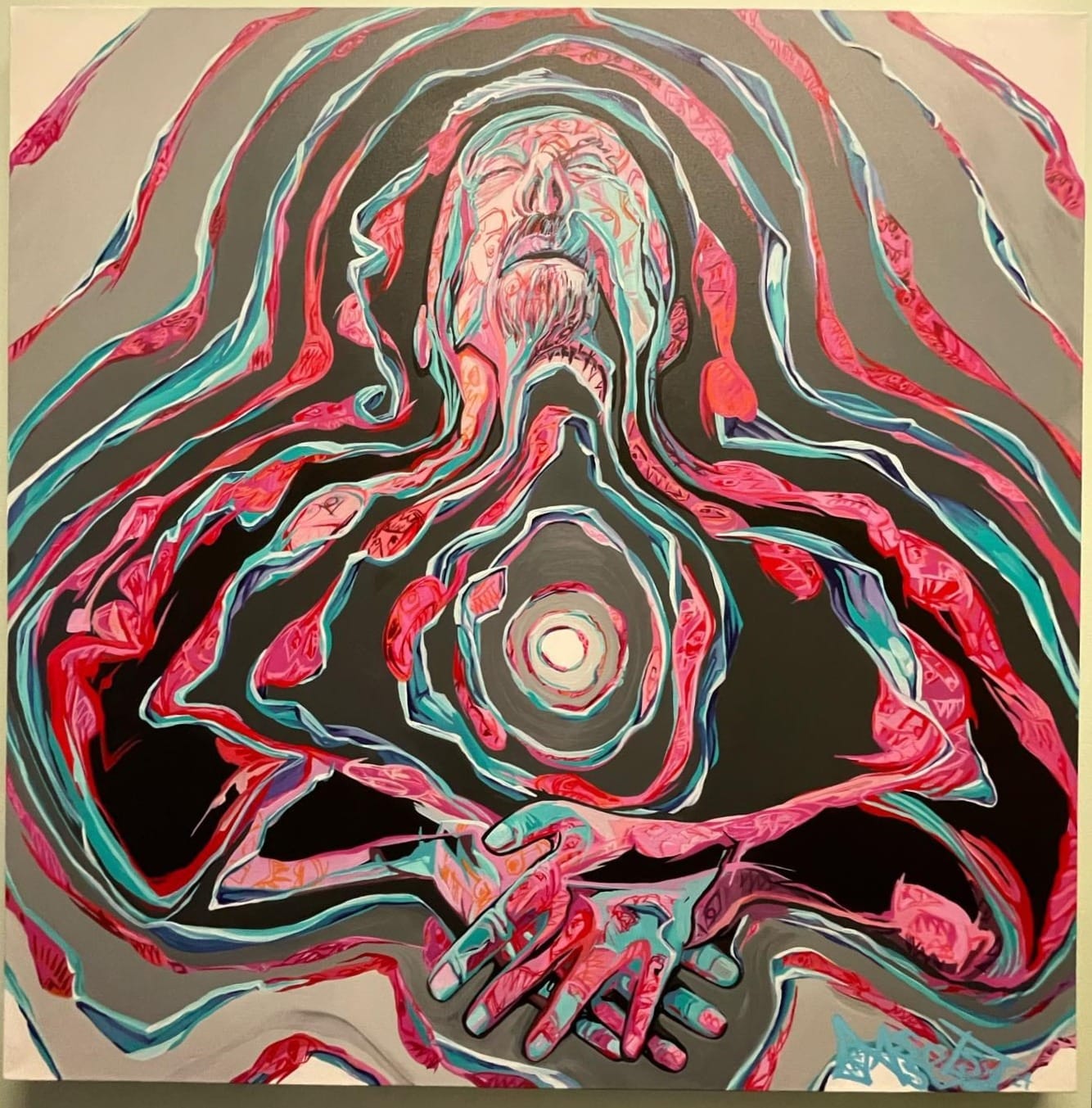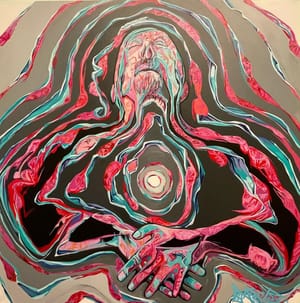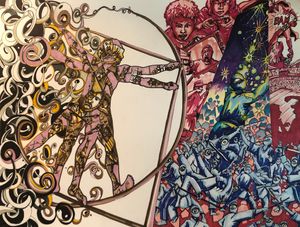
Origin
The last painting is The Leap Beyond Torii. Torii gates are traditional Japanese gates found at shrines and other sacred places in Japan and around the world. They represent philosophical ideologies—not religious ones, but metaphysical.
The torii is a symbol you see in gardens and sacred spaces: two pillars forming a gate that marks the transition from the mundane world to a sacred one that's always present. They're often painted in striking vermilion so they stand out in the world. They're also associated with warding off evil.
The bow we do in martial arts—in karate and the discipline of martial arts in general—has much to do with the torii gate. The idea is that as you pass through the gate, you bow to something in the universe greater than yourself. You bow to the universe so that the universe will eventually bow back to you. This is a nod to Morihei Ueshiba, the creator of Aikido, who spoke in these terms.
The torii gates mark symbolic boundaries, the threshold between the secular world and the sacred spaces we see in Shinto shrines. There's this concept of kami—a kind of deity or guardian spirit. They're not creators like you'd see in monotheistic religions such as Christianity or Islam. They represent a role, a higher order in ourselves where we become guardians. Through doing good work, we become weathered, even disfigured. We might appear like demons to some people who see the grizzliness of the work we're doing—the lines on our faces, our hair out of place, the anger, bitterness, and frustration that can accumulate over time.
These guardians stay here to suffer for us because they're wise enough to know they could leave—they see the way out. But they choose to stay. The torii gate has been created to say: if you're interested in that path, if you're willing to open your mind to something beyond the visible, beyond the mundane world, then anything you think is impossible becomes possible. But it begins with you moving toward the sacred.
You see this in indigenous ideologies and beliefs, in many ideologies shared worldwide about what the sacred might mean. But in general, it leads back to ourselves—to a relationship we have with something much larger than ourselves, through ourselves. Each fighting pattern I've talked about is an argument, ultimately. It really is.
When you're talking about the torii gate, you're talking about this argument in ourselves: Why? How come? I don't see anything. Where is it? This is silly, this is stupid. There's a lot of argument that takes place here. Whether it's the torii gate or the kata, I see the kata in these paintings much like that torii gate concept.
I'm using the kata as a gate—as pillars we pass through, not get stuck at. That threshold concept you see in the last painting is something a martial arts student has to resolve through the features of something they recognize, and through that recognition, polish. It's an insight that emerges slowly. It takes resilience and patience. I've seen many try—including myself—and fail, because it's so difficult to keep going when you can't make sense of it or understand why.
Again, that argument: I don't see it. It doesn't make sense to me. And then we begin to move away. This requires a type of guidance that's important for the art—guidance that is not asserted by arrogance, which we tend to see in martial arts: an absolute dictum of what is right and wrong, how to go about it, who is better than whom. That kind of arrogance can crush the fragile substance of the elusive insights a student may begin to discover in themselves.
The guidance needs to stem from sincerity. We need sincere instruction and guidance—a form of solidarity where the student carries and discovers what has been hidden in them all along. Through training, they begin to recognize it with this type of guidance and leadership. Eventually, they realize they are not thankful to whoever taught them or guided them, but that the thanks they have to give is to themselves.
This is where I think the true path of martial arts leads—beyond the gate, beyond the torii, beyond the recognizable or familiar in our world. This big red blazing gate we see as martial arts has to stand out against everything that otherwise appears mundane. For the best and greatest, there is no recognition or remembrance other than that their light, through their work, ignited and illuminated this process in another.
This is where real mastery is. The statement—"the master arrives without being seen and leaves without a trace"—is something to consider here in reference to the torii concept.





